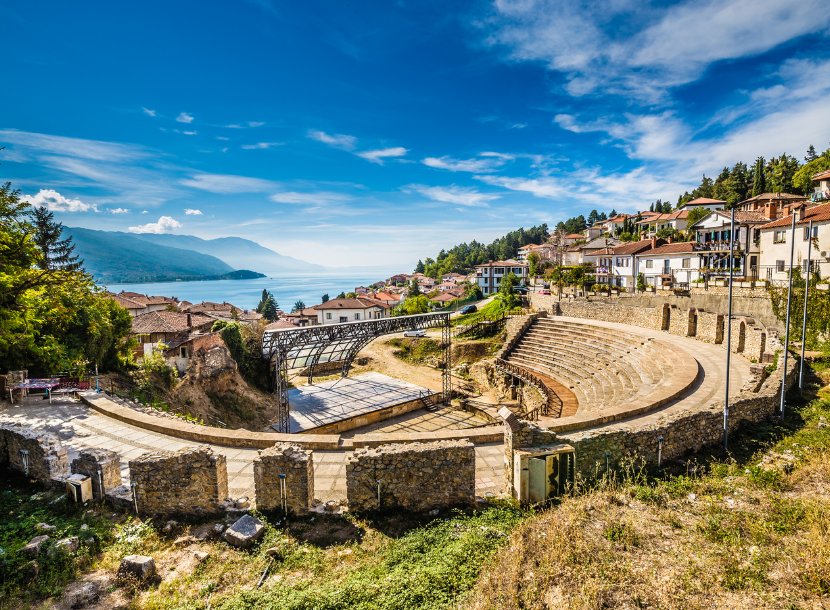Ancient Greece in the Balkans
Imagine walking in the footsteps of ancient philosophers, exploring cities where legends were born, and uncovering the secrets of a civilization that shaped the very foundations of Western culture.
Travel itinerary currently in preparation. Please check back soon.
- Pricing
- Duration
From: 1,860€/person
11 nights / 12 days
- Pricing
From: 1,860€/person
- Duration
11 nights / 12 days
- Starting point
- End point
Belgrade
Zagreb
- Starting point
Zagreb
- End point
Belgrade
Imagine walking in the footsteps of ancient philosophers, exploring cities where legends were born, and uncovering the secrets of a civilization that shaped the very foundations of Western culture. The Balkans, a land where East meets West, represents a treasure trove of Ancient Greek heritage waiting to be explored. Ancient cities reveal priceless stories because here, history is not just learned but experienced, as ruins whisper tales of gods, heroes, and ordinary people whose lives shaped our world.
Greek culture has left an indelible mark through philosophy and science, establishing schools that transmitted knowledge throughout the Balkans. Greek art and architecture shaped the sculpture and urban planning of the region, while the Greek language contributed to the development of local scripts, including Cyrillic. Greek myths and gods were integrated into local traditions, enriching the spiritual landscape of the Balkans.
Tour itinerary
Day 1: Belgrade, Serbia
Arrival in Belgrade and transfer to accommodation. After checking into the hotel, enjoy a brief rest and refreshment before beginning our adventure. We’ll start exploring Serbia’s capital with a leisurely walk through Knez Mihailova Street, Belgrade’s main pedestrian zone. This historic street is filled with shops, cafes, and beautiful buildings that showcase Balkan architecture. Take some time to observe street artists and enjoy the city’s vibrant atmosphere. We’ll have a group dinner at a local restaurant to taste traditional specialties. Return to the hotel. Overnight stay.
Day 2: Belgrade – Apollonia, Albania
After breakfast, we’ll depart by bus for Apollonia, the forgotten city of philosophers located near modern-day Fier in Albania. The journey takes around 8 hours, giving you the chance to enjoy beautiful landscapes while passing through lush green areas and picturesque Balkan villages. Upon arrival in Apollonia, we’ll check into the hotel and rest before an evening stroll around town. Dinner at a local restaurant to enjoy regional specialties. Return to the hotel. Overnight stay.
Day 3: Apollonia – The Forgotten City of Philosophers
Breakfast. After breakfast, we’ll tour Apollonia, a city that was once a center of philosophy and art. We’ll explore the ancient fortified walls, where you’ll see a stepped wall with an arched gate, and visit the Monument of Agonothetes, a symbol of academic competition and philosophical debate. We’ll also visit Apollonia’s library, once a home to the teachings of philosophers and thinkers, and the Church of Saint Mary, which reflects the city’s religious history. A walk through these ancient structures offers insight into the daily life and spiritual practices of Apollonia’s residents. Free time for individual activities, a stroll through the historic part of town, and enjoying the atmosphere of the old city and local life. Return to the hotel. Overnight stay.
Day 4: Apollonia – Butrint
Morning: After breakfast, we’ll head to Butrint, a mystical UNESCO World Heritage site. The journey takes around 4 hours, providing an opportunity to enjoy Albania’s beautiful landscapes as we approach this ancient city. Upon arrival in Butrint, we’ll check into the hotel and start exploring this historic site, which was a Greek colony and later a Roman city. A walk through the historical part of the city lets you experience the harmony of Butrint’s natural and cultural heritage. Surrounded by the azure waters of the Ionian Sea, this city offers spectacular views and a rich history reflected in its landmarks. Overnight stay.
Day 5: Butrint – The Mystical World Heritage City
Breakfast. Today is dedicated to fully immersing ourselves in the history of Butrint. We’ll visit the Ancient Theater, the Temple of Asclepius, and the Baptistery, uncovering the layered history of this city that has survived Greek, Roman, Byzantine, and Venetian influences. A walk through ruins from different epochs allows us to step back in time and understand the city’s complex history. Every stone in Butrint tells a story, while the ruins reveal the daily life, religious customs, and trade activity of ancient residents. Free time to enjoy the city’s natural beauty and tranquil atmosphere. Overnight stay.
Day 6: Butrint – Ohrid, North Macedonia
Breakfast. After breakfast, we’ll travel by bus to Ohrid, known as the “Jerusalem of the Balkans.” The journey takes about 5 hours, allowing us to enjoy North Macedonia’s beautiful landscapes. Upon arrival in Ohrid, we’ll check into a hotel with a spectacular view of Lake Ohrid, providing the perfect backdrop for an evening walk through the town. Ohrid is known for its rich history, cultural heritage, and natural beauty. An evening stroll along the lake lets you enjoy the serene atmosphere and stunning views of one of Europe’s oldest and deepest lakes.
Day 7: Ohrid – The City of Light and Learning
Breakfast. After breakfast, we’ll visit the ancient theater from the Hellenistic period, now a venue for cultural events and performances. This theater, located by the lake, offers an impressive look at the architecture and artistic tradition of the ancient city. You can observe how history and culture blend into daily life in Ohrid. A visit to Samuel’s Fortress offers spectacular views of the town and the lake. Situated on a hilltop, the fortress reflects Ohrid’s strategic importance over the centuries. Afterward, we’ll visit the Church of Saint Sophia, an impressive Orthodox church with 11th-century frescoes that blend traditional architecture with rich artistic expression.
Free time for individual activities and a walk through Ohrid’s old quarter. With its narrow streets, traditional houses, and local shops, this quarter exudes history and culture, giving you a chance to experience the city’s authentic atmosphere. Overnight stay.
Day 8: Ohrid – Heraclea Lyncestis
Breakfast. After breakfast, we’ll take a two-hour bus ride to Heraclea Lyncestis, a strategic city founded by Philip II of Macedon, Alexander the Great’s father. We’ll tour the Roman baths, ancient theater, and stunning mosaics depicting mythological scenes. Heraclea Lyncestis, near today’s Bitola, was a key point on the Via Egnatia, an important trade route connecting the Adriatic and Aegean seas. Exploring this city provides insight into the transition from the Hellenistic to the Roman period and the evolution of civilization over the centuries. Return to the hotel. Overnight stay.
Day 9: Ohrid – Stobi, North Macedonia
Breakfast. We’ll travel by bus to Stobi, an archaeological treasure in North Macedonia. (The journey takes about 3 hours). Stobi, located at the confluence of the Crna and Vardar rivers, was a trade and religious center that thrived from the Hellenistic to the early Byzantine period. We’ll explore the Roman amphitheater, synagogue, and numerous mosaics that reflect the city’s cultural diversity. Each stone in Stobi tells a story, while the ruins reveal the daily life, religious customs, and trade activity of ancient residents. Return to Ohrid. Overnight stay.
Day 10: Ohrid – Sozopol, Bulgaria
Breakfast. After breakfast, we’ll head to Sozopol, Bulgaria’s oldest city with Greek roots. (The journey takes about 9 hours by bus). Upon arrival in Sozopol, we’ll check into the hotel and rest until an evening walk through Sozopol’s Old Town. Once known as Apollonia Pontica and founded by Greek settlers from Miletus in the 7th century BC, Sozopol today offers visitors a range of opportunities to explore the old town and archaeological sites. An evening walk through the Old Town lets you experience the harmony of ancient and modern dynamics of the city. Enjoy the magnificent views of the Adriatic Sea and local seafood specialties. Overnight stay.
Day 11: Sozopol – Bulgaria’s Oldest City with Greek Roots
Breakfast. After breakfast, we’ll visit Apollonia Pontica, the temple dedicated to Apollo, reflecting the Greek influence on local culture. An exciting exploration of the temple’s architecture, along with an introduction to the history of Sozopol as a trading and cultural center. A visit to Sozopol’s archaeological museum provides insight into artifacts from the Greek period, while a walk through the Old Town allows us to enjoy the blend of ancient and modern urban life. Sozopol combines elements of Greek, Roman, and Byzantine culture, creating a unique atmosphere that attracts visitors from around the world. Overnight stay.
Day 12: Sozopol – Nesebar, Bulgaria
Breakfast. A short drive (1.5 hours) brings us to Nesebar, a UNESCO city known as the “Living Museum of Ancient Civilization.” Situated on a small peninsula, Nesebar boasts a rich history encompassing Greek, Roman, and Byzantine periods. A walk through the old fortifications and exploration of the city’s layered history through its well-preserved buildings. Visiting churches from different epochs offers insight into the religious history and architectural trends that shaped Nesebar over the centuries. Free time for individual activities and to enjoy the extraordinary beauty of this coastal city. Overnight stay.
Pricing
Starting from:
2,100€/person
Included in price
- English-speaking tour guide
- Comfortable transportation
- 6 nights in 4* hotel accommodation, half-board service
- All entrance fees and activities as specified in the itinerary
Not included
- Single room supplement
- Personal expenses
Ancient Greece in the Balkans: Traces of an Ancient Civilization
Greek culture has left an indelible mark through philosophy and science, establishing schools that transmitted knowledge throughout the Balkans. Greek art and architecture shaped the sculpture and urban planning of the region, while the Greek language contributed to the development of local scripts, including Cyrillic. Greek myths and gods were integrated into local traditions, enriching the spiritual landscape of the Balkans.
Apollonia – The Forgotten City of Philosophers in Albania
Located near the modern city of Fier, Apollonia was one of the most significant Greek cities on the Adriatic. Founded in the 6th century BCE by Greek colonists from Corinth and Corfu, Apollonia became a center of philosophy and art. The city was known for its school of philosophy, which was attended, among others, by the future Roman Emperor Augustus Octavian.
Today, visitors can explore the ruins of the Agora, Odeon, and temples dedicated to the god Apollo. These remnants provide insight into the architectural achievements and cultural significance of the city.

Butrint, Albania – The Mystical UNESCO World Heritage Site
On a picturesque peninsula surrounded by the azure waters of the Ionian Sea lies Butrint, a city rich in myth and 2,500 years of history. Legend says it was founded by Trojan exiles, and its layers of ruins reveal a tapestry of Greek, Roman, Byzantine, and Venetian influences. Historically, Butrint was a Greek colony and later a Roman city.
Today, with landmarks like the Ancient Theater, the Temple of Asclepius, and the Baptistery, it is part of the UNESCO World Heritage.

Ohrid, North Macedonia – The Jerusalem of the Balkans
Known as Lychnidos – the City of Light – in antiquity, Ohrid was an important city on the Via Egnatia route, which connected the Adriatic and Aegean Seas. The city was a center of Greek culture and education and later became the seat of Slavic literacy and Christianity.
Situated on the shores of one of Europe’s oldest and deepest lakes, Ohrid is a city where time seems to stand still. Today, visitors can see the ancient theater from the Hellenistic period, Samuel’s Fortress, and the Church of St. Sophia, which combines historical foundations and 11th-century frescoes. Ohrid bridges the past and present through its rich cultural and natural beauties.

Heraclea Lyncestis – The Crossroads of Macedonia
Founded by Philip II of Macedon, the father of Alexander the Great, Heraclea Lyncestis lies near the modern city of Bitola. This strategic city flourished during the Hellenistic and Roman periods due to its position along the Via Egnatia.
Visitors can admire stunning mosaics depicting mythological scenes in ancient basilicas, walk through the ruins of Roman baths, and sit in the ancient theater where performances are still held today, bridging the past and present. Heraclea provides insight into the transition from the Hellenistic to the Roman period and is definitely a place where you can feel the spirit of the ancient world and its evolution through the ages.

Stobi – The Archaeological Treasure of North Macedonia
At the confluence of the Crna (Black) River into the Vardar lies Stobi, a city that flourished from the Hellenistic to the early Byzantine period. It was a commercial and religious center, and its mosaics, amphitheater, and synagogue reflect the cultural diversity and richness of the civilizations that intertwined here.

Sozopol – Bulgaria’s Oldest City with Greek Roots
Once known as Apollonia Pontica, Sozopol was founded in the 7th century BCE by Greek colonists from Miletus. The city was an important trading and cultural center, known for its temple dedicated to Apollo.
Today, visitors can enjoy the old town with narrow streets, wooden houses, and an archaeological museum that preserves fascinating artifacts from the Greek period.

Nessebar, Bulgaria – A Living Museum of Ancient Civilization
Located on a small peninsula, Nessebar is one of the oldest cities in Europe. Founded as Mesambria by the Thracians, it became a colony of Doric Greeks in the 6th century BCE.
Today, it is a UNESCO World Heritage site, known for its rich history that encompasses Greek, Roman, and Byzantine periods. It boasts a layered past evident in well-preserved city fortifications, temples, and churches from various epochs. The combination of Thracian origins and Greek influence makes Nesebar a unique place that reflects the layered history of the Balkans.


